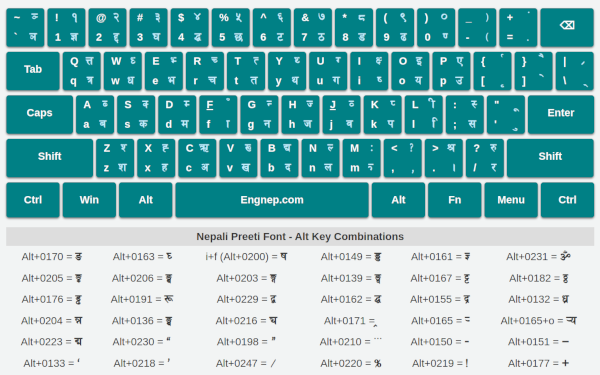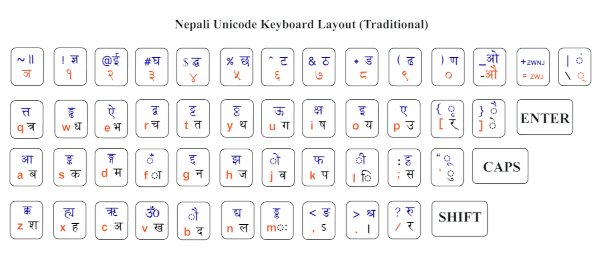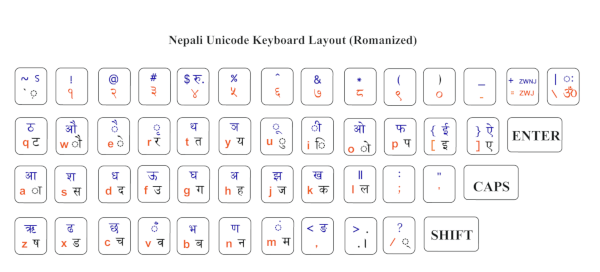Typing in Nepali can be done in different ways depending on the keyboard layout you use. Over the years, three major systems have become popular: Preeti layout, Unicode layout (Traditional or Romanized), and Phonetic typing. Each layout has its advantages and disadvantages, and the "best" one depends on your needs.
Let's compare Preeti, Unicode, and Phonetic layouts, explain how they work, and help you choose the right keyboard for your typing purpose.
1. Preeti Keyboard Layout

What is Preeti?
- Preeti is one of the earliest and most widely used non-Unicode Nepali fonts.
- Developed in the 1990s, it became the standard for typing in government offices, newspapers, and schools in Nepal.
- Preeti maps Devanagari characters onto the English (Roman) QWERTY keyboard.
Features of Preeti Layout:
- Based on the English QWERTY system but not Unicode-compatible.
- Required to install Preeti font in order to display properly.
- Popular for printing, old documents, and official forms in Nepal.
Pros ✅
- Still widely recognized in offices and print media.
- Many older users and institutions are already comfortable with it.
- Lots of pre-made Preeti fonts available.
Cons ❌
- Not Unicode, so it doesn't display correctly on the web, email, or modern apps.
- Needs conversion before publishing online (Preeti → Unicode).
- Difficult for beginners (letter positions don't always match pronunciation).
2. Unicode Keyboard Layout
What is Unicode?
- Unicode is the global standard for encoding text, supported by all major platforms, browsers, and search engines.
- In Nepali, Unicode keyboards are based on traditional layout or Romanized layout.
Unicode Layout Options:
1. Traditional Layout

This layout is close to the popular Preeti font. Best to use this if you are already familiar with the font.
2. Romanized Layout

This layout is easier for beginners. It maps Nepali letters closer to their English sounds.
Typing Non-existing Characters Using a Unicode Keyboard
- क्ष = क + ् + ष
- त्र = त + ् + र
- ज्ञ = ज + ् + ञ
- त्त = त + ् + त
- द्ध = द + ् + ध
- श्र = श + ् + र
- द्य = द + ् + य
Features of Unicode Layout:
- Works universally on websites, mobile apps, and digital platforms.
- Doesn't need special fonts installed.
- Ideal for SEO, emails, and publishing online.
Pros ✅
- Standardized and future-proof.
- Works across all operating systems and devices.
- Recognized in official exams and government forms.
Cons ❌
- Steeper learning curve compared to phonetic typing.
- Older Preeti users may find it difficult to switch.
3. Phonetic Nepali Typing
There's no physical "keyboard" layout for this Romanized typing. You simply use your regular QWERTY keyboard to type your text. A piece of software is used behind the scene to map the English letters to Nepali.
What is Phonetic Typing?
- Phonetic typing allows users to type Nepali by entering how they sound.
- Example: Typing "ramro" → appears as "राम्रो".
How It Works:
- Available in tools like Google Input Tools, Engnep Typing Tool, and Gboard (Google Keyboard).
- Does not require memorizing key positions – just type how words sound.
Pros ✅
- Easiest for beginners and casual users.
- No need to memorize keyboard layout.
- Works well on mobile phones and quick typing.
Cons ❌
- Requires internet for some tools (like Google Input Tools online).
- Accuracy depends on spelling (wrong Roman spelling = wrong Nepali word).
- Not preferred for official use (exams may demand Unicode layout).
Comparison Table
| Feature | Preeti Layout | Unicode Layout | Phonetic Typing |
|---|---|---|---|
| Compatibility | Needs Preeti font | Universal (Unicode standard) | Universal (via tools) |
| Best For | Printing, legacy docs | Official, exams, SEO, publishing | Beginners, quick typing |
| Learning Curve | Moderate | Steep | Very Easy |
| Online Support | ❌ Limited | ✅ Full Support | ✅ Full Support |
| Conversion Required | Yes (Preeti to Unicode) | No | No |
Which Keyboard Layout Should You Use?
- If you're a student or preparing for exams → Use Unicode layout.
- If you work in offices or handle old documents → You may still need Preeti, but convert to Unicode for digital use.
- If you're a beginner or casual user → Use phonetic typing on Gboard or Engnep Typing Tool.
Conclusion
Nepali typing can be done through Preeti, Unicode, or Phonetic layouts.
- Preeti is useful for legacy documents but not future-proof.
- Unicode is the global standard, official, and best for web publishing.
- Phonetic is the easiest for beginners and mobile users.
If you are starting fresh, learn Unicode typing because it works everywhere and will save you from future conversion headaches. For beginners, phonetic tools can help you get started quickly.